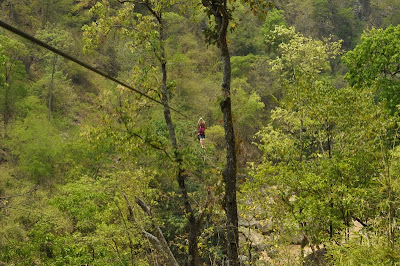Thai food is awesome. If you've ever had any, you know what I'm talking about. Thai food in Thailand is even better! So, we had to take a cooking class to show us how to make authentic Thai food. Here's Jennifer - with a knife! We had to chop up a lot of really unique ingredients, like lemon grass, turmeric, galengal, finger ginger, and of course super-hot Thai chilies!
The standard Thai cooking method is stir-fry in a wok. We all got to have a chance to cook our own food in a wok. For those of you that have never cooked in a wok - it's really fun! You should definitely try it!!
The first thing we made was phad thai, or fried noodles. Here is a picture of my finished product. I cooked it, then I ate it, and I lived to tell the tale.
We also made the most famous of all thai dishes - green curry! A pre-requisite for authentic green curry is, of course, green curry paste. I took a turn mashing the lemon grass, chilies, scallions, and varieties of ginger root in this stone mortar and pestal. Cool hat, huh?
The other main ingredient in green curry is coconut milk. We milked our own coconuts by soaking the flesh in water and then squeezing the milk through a cheese cloth. Here is Jennifer as a coconut milk maid! Her mom would be proud!
In case you're wondering, Craig was not interested in cooking. Instead, he provided entertainment to the staff by showing them how to use the iBabysitter (iPad to all the rest of you).
Can't you just smell the yummy spicy but sweet with baby eggplant, corn, chicken galengal, turmeric, finger ginger and lemongrass goodness? Okay, gotta run to eat some of that stuff!
Okay, I'm back! Chaing Mai is part of the Silk Road due to it's close proximity to the Golden Triangle (where Thailand, Laos, and China all intersect). As such, there are many silk villages nearby that still produce silk products. We got to see how Thai silk is made. It all begins when a silk moth lays a small egg. Those small yellow specs are actually silkworm eggs!
Eventually that small little dot hatches into tiny silkworms or caterpillars, that eat mulberry leaves. These worms just eat and eat and eat, until they get to me about an inch and a half in length.
Once they are big enough they start to spin their cocoon. The cocoon is made of a long, thin, continuous strand of pure silk.
Next comes the part where humans take the cocoons and turn it into silk yarn. The process starts with boiling the cocoons to kill the worms. Then, the silk is pulled out of the pot and wound into a bundle of yarn using a spindle.
Here's craig next to a pile of silk yarn. The yellow colored silk is raw, untreated silk. The blue and white bundles have been dyed.
So, that concludes the 5 post series about Chiang Mai! We did so much in just a few days there, that it took this many posts just to give you a sense of how much fun we had. Stay tuned for more posts from Hong Kong, Bali, and other places in Thailand and Malaysia!!





























































